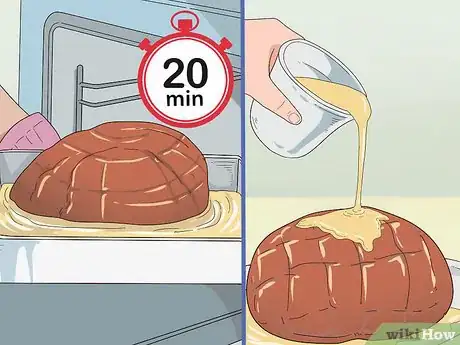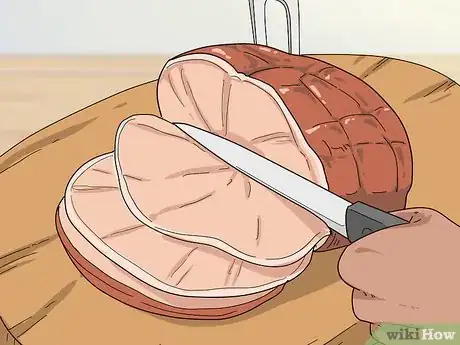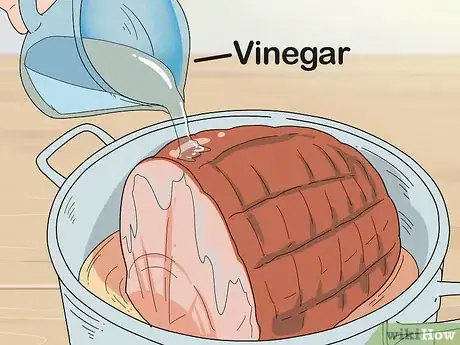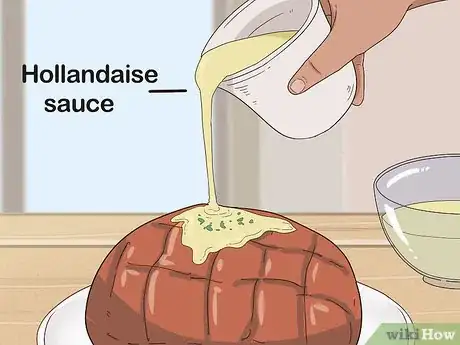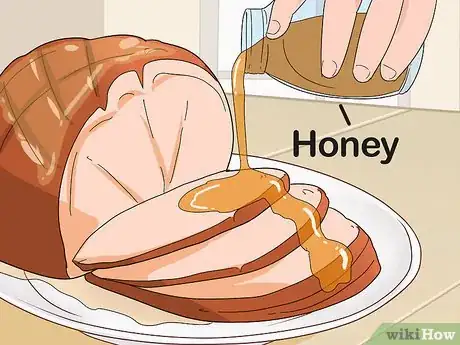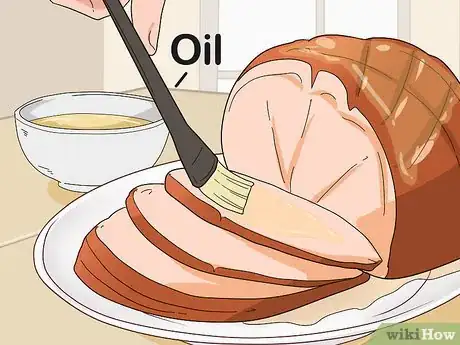This article was co-authored by wikiHow Staff. Our trained team of editors and researchers validate articles for accuracy and comprehensiveness. wikiHow's Content Management Team carefully monitors the work from our editorial staff to ensure that each article is backed by trusted research and meets our high quality standards.
This article has been viewed 84,816 times.
Learn more...
Cooked ham can be a bit too salty sometimes, but there are different ways to balance out the flavor. Soak your ham in water before heating it, drain the salty drippings while cooking it, or serve it with neutralizing side dishes to even out the taste. You can also try to offset the saltiness by adding ingredients to the ham, such as vinegar, lemon, honey, butter, oil, or a creamy sauce.
Steps
Reducing the Salt
-
1Soak the ham before heating it. Place the ham in a large bowl or pot and pour cold water over it until it is covered. Let it soak in the fridge overnight to give time for the salt to soak out into the water. Remove the ham from the water and pat it dry with a paper towel before heating it in the oven.
-
2Drain the ham drippings while it heats. Prepare your ham with your choice of glaze or seasonings and place it in the oven to cook. After 20 minutes of baking, remove the ham from the oven and carefully pour off the pan drippings, which will be very salty. To retain moisture, add more glaze or seasonings and place the ham back in the oven.
- For a larger sized ham, wait an additional five to ten minutes before pouring off the pan drippings.
Advertisement -
3Serve the ham with neutralizing sides. Offset the saltiness of your ham by serving it with neutralizing side dishes. Potatoes, rice, and pasta are bland enough to round out the overall flavor of your meal. Avoid using pre-packaged side dishes, which are likely to be high in sodium on their own.[1]
-
4Slice the ham very thinly. To reduce the intensity of the ham's saltiness, cut it into very thin slices before serving it. Thick slices of ham can overpower a meal with their salt-heavy taste. Use a sharp kitchen knife to cut the ham as evenly as possible.
Adding Ingredients
-
1Pour vinegar on the ham. Add a teaspoon of distilled vinegar to a medium-sized, over-salted cooked ham before heating it. The acidity of the vinegar will counteract the saltiness and even out the flavour. Pour the vinegar over the ham slowly to cover it evenly.
- Avoid adding too much vinegar to the ham, which will create a sour flavor.
-
2Squeeze a lemon onto the ham. Cut a small lemon in half and squeeze both parts over the ham. Disburse the lemon juice evenly so that the ham is evenly covered. The tanginess of the lemon will offset the extra saltiness.[2]
- Do this before heating the ham.
-
3Cover the ham with a creamy sauce. Adding a creamy sauce (e.g., hollandaise sauce) to your ham will help to mask its saltiness. The creamy component will make the dish taste milder and balance out the flavour. Pour the sauce over sliced pieces of ham before serving it.[3]
-
4Drizzle honey on the ham. Pour honey on your ham to reduce its saltiness. Salty and sugary flavors balance each other out, and honey complements ham perfectly. Add enough honey to coat the ham entirely (approximately 1 cup [250 ml] for a 5 lb/0.5 kg ham).[4]
- You can also drizzle honey on sliced pieces of ham before serving it.
-
5Baste the ham with oil or butter. Adding an extra source of fat (e.g., oil or butter) to your ham will add an extra layer of flavour to "absorb" the saltiness of the meat. Baste your ham with a basting brush dipped in olive oil or melted butter, coating the entire ham. Be sure to use unsalted butter to avoid adding to the saltiness.[5]
- For best results, baste the ham halfway through heating it.
Community Q&A
-
QuestionHow do I desalt ham after it has been baked?
 Community AnswerPut it in a dish of milk for 15 minutes to desalinate.
Community AnswerPut it in a dish of milk for 15 minutes to desalinate. -
QuestionA cured and fully cooked 1/2 ham––should it be soaked or not?
 TiaCommunity AnswerMost store-bought hams are city hams. They've been soaked in brine (wet-cured) and then either smoked or boiled before being sold fully cooked.
TiaCommunity AnswerMost store-bought hams are city hams. They've been soaked in brine (wet-cured) and then either smoked or boiled before being sold fully cooked.
References
- ↑ http://www.organicauthority.com/foodie-buzz/too-salty-too-spicy-how-to-balance-seasoning-mistakes-while-you-cook.html
- ↑ http://www.epicurious.com/expert-advice/how-to-save-food-thats-too-salty-article
- ↑ http://www.epicurious.com/expert-advice/how-to-save-food-thats-too-salty-article
- ↑ http://thestonesoup.com/blog/2014/11/how-to-fix-excess-salt/
- ↑ http://www.organicauthority.com/foodie-buzz/too-salty-too-spicy-how-to-balance-seasoning-mistakes-while-you-cook.html

